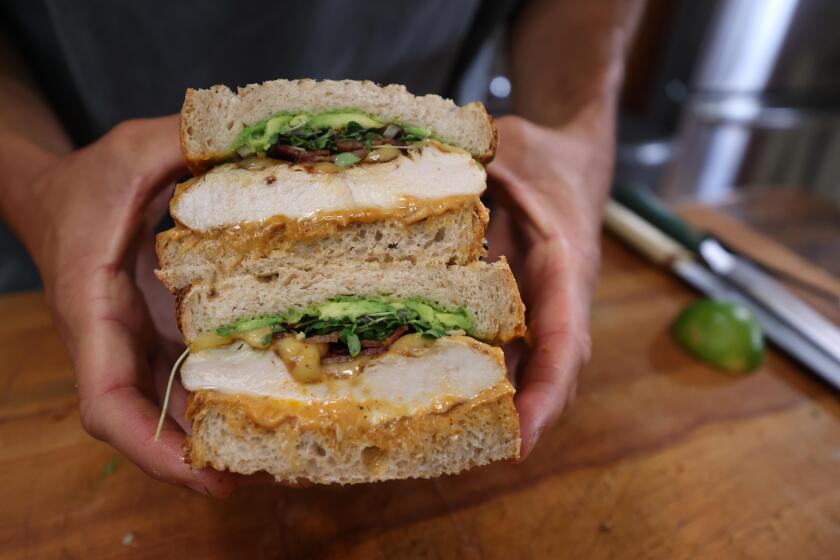Instagram or it didn’t happen? L.A. restaurants show how the app has changed their industry
For Helene Henderson, Instagram has become synonymous with the dining experience at Malibu Farm. Henderson owns the farm-to-table restaurant on Malibu’s pier and credits Instagram with transforming the once quiet, seaside shack — which opened in 2014 — into a busy destination.
“A meal that is not photographed probably did not happen,” Henderson said. “Instagrammers can be a boost for restaurant check averages when more dishes are ordered than necessary, just for the perfect photo op.”
The Mason jars featuring the Malibu Farm logo are frequently shared on Instagram. The colorful jars, in conjunction with the restaurant’s scenic backdrop, make the ideal combination for photographers. Though the jars were originally designed for a more practical purpose, Henderson sees their popularity on Instagram as a business-boosting strategy. The restaurant’s account, @malibufarm, has more than 21,000 followers.
In recent years, the social media app has become much more than an outlet for selfies. Restaurants in Los Angeles and elsewhere are experiencing firsthand how Instagram has changed the way the culinary industry operates. The app is now home to 25 million business accounts, the vast majority of which are small businesses. That number has rapidly increased in recent months, expanding by 10 million since July. According to Instagram, more than 80% of users follow a business account, while 200 million users actively visit a business profile every day.
June Quan, co-owner of Shrimp Daddy, the Hawaiian shrimp vendor at the Smorgasburg Sunday market in downtown L.A, has 160,000 followers on Instagram. With her large following, she’s considered an Instagram “influencer” — someone who posts to the app and often gets paid to suggest products and brands to their followers. She believes this experience has helped her design a business with social media in mind. Shrimp Daddy’s business account, @eatshrimpdaddy, has nearly 30,000 followers.
Using her knowledge of Instagram, and which photos get the most likes, Quan decided to serve one of the two dishes on the Shrimp Daddy menu in a hollowed out pineapple bowl — designed specifically to be photographed and posted.
“We have customers who have driven for hours to get one of our bowls,” she said, “We’ve maxed out on how many pineapples we can bring, but the demand keeps growing.”
Bryan Leong and Stephanie Wang, owners of Amazebowls, a restaurant that sells artistically designed acai bowls, say they have seen a similar rush of first-time diners, who are presumably hoping for a shot of their acai served in a real coconut shell. Since starting as a food truck in 2014, Amazebowls has expanded to a permanent station at Smorgasburg and brick-and-mortar restaurants in Venice and the Arts District.
“Instagrammable food has a way of bringing people together,” said Leong. “We had a good feeling, but we had no idea our coconut bowls would be so successful.”
The promise of a great picture may get customers through the door — but how to get them back?
“We have tons of Instagrammers come in after seeing the coconut bowl online and want to try it themselves,” Leong said. “But if they come back, they want to go for a normal, cheaper acai in a plastic bowl.”
The Los Angeles food scene isn’t just adapting menus with Instagram in mind. Social media has become a marketing tool, says Jonathan Grahm, owner of luxury chocolate house Compartés. The company, @compartes, has 211,000 followers on Instagram.
“A beautiful product compels people to post it,” he said. “I get excited, because it’s essentially free advertisement.”
Grahm adds he has designed his shops to be reminiscent of art museums, with such embellishments as neon signs, a wall lined with chocolate bars and chocolate on tap to inspire customer photography.
“It’s a little piece of luxury that doesn’t cost a fortune,” he said. “We’ve got the most sharable chocolate out there.”
Average posters help spread the word, but those Instagram influencers — with sizable followings, often in the hundreds of thousands — might have the power to reach users who may not find a restaurant on their own. Chris Coombs, co-owner of the Boston Urban Hospitality restaurant group in the Massachusetts city, isn’t taking this for granted.
“Instagram has revolutionized the way restaurants advertise,” he said. “It has expanded the reach of the food world exponentially.”
Coombs has hired a full-time social media manager to control the accounts of all his restaurants and has made boosting their Instagram presence a priority. Along with posting, the social media manager researches popular hashtags, engages with past and future patrons via Instagram, and tracks social media trends to keep their account on the cutting edge.
Coombs’s newest restaurant, Boston Chops, in the city’s Downtown Crossing neighborhood, has a table specifically intended for food photography. At first glance, it looks like a standard four-person dining table nestled in a private corner of the restaurant. But it’s reserved for writers, photographers and social media users with many followers. It has its own programmed lighting separate from that of the rest of the restaurant, so that patrons can try for the perfect photo, even in a dimly lighted dining room.
“We want influencers to have a seamless dining experience,” Coombs said. “They also want perfect photos. This way, they get essentially a mini photo studio in real time.”
Restaurant owners have started to embrace Instagram as a method of attracting future customers, but many L.A. eateries mention annoyances with the new Instagram culture too.
“It can be frustrating when several tables are standing on their chairs to capture their image,” said Henderson.
Leong and Wang said they have been pressured by social media users to pay up in exchange for posts about the restaurants on their accounts, adding that they refuse these requests on a regular basis.
“We have had people buy one of our ice cream sandwiches, take a picture and then throw it away,” said Lucy Danovic, general manager of the Milk Shop (@themilkshop_la), a Silver Lake ice cream shop with 60,000 Instagram followers. “The Instagram Effect has taken priority for customers over flavor and taste.”
Henderson has had to learn the ins and outs of social media culture on the job, but she still believes it has helped motivate her to be more innovative and improve her restaurant.
“You have to be more than a restaurant with good photo opportunities to survive in today's ultra-competitive restaurant market,” said Henderson. “You need to work daily to make sure the actual experience exceeds the expectations created by Instagram.”
ALSO:
Sugary spectacles: Desserts that deserve a standing ovation
How local farmers are coping with the devastating Thomas fire
Christmas beer: Holiday brews from Belgium, Germany, Britain and the United States
Eat your way across L.A.
Get our weekly Tasting Notes newsletter for reviews, news and more.
You may occasionally receive promotional content from the Los Angeles Times.







